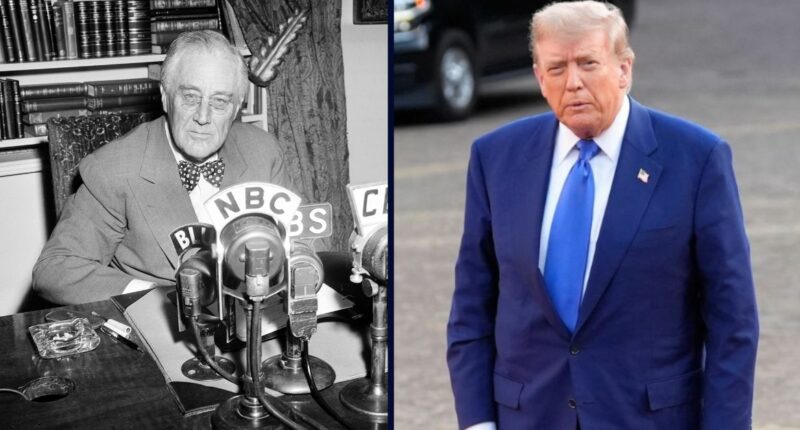Share this @internewscast.com
Left: U.S. President Franklin Roosevelt is captured moments before delivering his “On the Fall of Rome” Fireside Chat from the White House in Washington on June 5, 1944 (AP Photo). Right: President Donald Trump is seen posing for photographers upon arriving for a formal dinner at the Paleis Huis ten Bosch ahead of the NATO summit in The Hague, Netherlands, on Tuesday, June 24, 2025 (AP Photo/Alex Brandon).
A federal judge based in Washington, D.C., issued a permanent order barring President Donald Trump’s employees from interfering with a “legitimate Commissioner” of the Federal Trade Commission (FTC) from completing her full seven-year term.
U.S. District Judge Loren AliKhan highlighted that the “circumstances” of this particular case “closely resemble” the situation in a 90-year-old Supreme Court case, Humphrey’s Executor v. United States. In that case, the estate of an FTC commissioner successfully argued that President Franklin Delano Roosevelt could not dismiss William Humphrey without just cause due to policy disagreements, securing backpay for the commissioner.
The 1935 unanimous SCOTUS ruling was clear that “inefficiency, neglect of duty, or malfeasance” were the only causes for firing an FTC commissioner, as Congress expressly intended to insulate the independent fair competition agency from being unfairly subjected to the whims of the executive and, by extension, politicization and dysfunction.
FTC Commissioners Rebecca Slaughter and Alvaro Bedoya filed suit against Trump, FTC Chair Andrew Ferguson, FTC Commissioner Melissa Holyoak, and FTC Executive Director David Robbins in the U.S. District Court for the District of Columbia back in March.
Slaughter and Bedoya claimed that the president removed them without cause — in direct contravention of the law, which says: “Any Commissioner may be removed by the President for inefficiency, neglect of duty, or malfeasance in office.”
“In short, it is bedrock, binding precedent that a President cannot remove an FTC Commissioner without cause,” the plaintiffs’ lawsuit said. “And yet that is precisely what has happened here: President Trump has purported to terminate Plaintiffs as FTC Commissioners, not because they were inefficient, neglectful of their duties, or engaged in malfeasance, but simply because their ‘continued service on the FTC is’ supposedly ‘inconsistent with [his] Administration’s priorities.'”
“The President’s action is indefensible under governing law,” they added.
On Thursday, AliKhan agreed, handing Slaughter a permanent injunction blocking her ouster at the summary judgment stage of the litigation, deciding the issue of Slaughter’s reinstatement without need for a trial.
The judge, appointed by then-President Joe Biden in 2023, repeatedly referred to the Humphrey’s Executor case because it “remains good law today” and the Supreme Court “has declined to revisit or overrule it” in the 90 years since, even if justices have at times cast doubt about the holding in dicta or remarks that are not binding on lower courts.
“The answer to the key substantive question in this case—whether a unanimous Supreme Court decision about the FTC Act’s removal protections applies to a suit about the FTC Act’s removal protections—seems patently obvious,” said AliKhan. “In arguing for a different result, Defendants ask this court to ignore the letter of Humphrey’s Executor and embrace the critiques from its detractors. Defendants hope that, after doing so, this court will bless what amounts to the implied overruling of a ninety-year-old, unanimous, binding precedent.”
Unsurprisingly, the judge imparted no such blessing. Instead, AliKhan noted that, like in the dispute between Humphrey and FDR, Slaughter was not fired for “inefficiency, neglect of duty, or malfeasance in office,” but because Trump deemed her “continued service on the FTC [was] inconsistent with [his] Administration’s priorities.”
“These facts almost identically mirror those of Humphrey’s Executor. President Roosevelt did not hide his motivation for removing Commissioner Humphrey: the President explained ‘that the aims and purposes of [his] Administration with respect to the work of the Commission c[ould] be carried out most effectively with personnel of [his] own selection,'” AliKhan wrote.
The judge then sharply rejected the Trump administration’s argument that the Humphrey’s Executor case would not have been decided the same way in this day and age.
“Defendants are not the first litigants to sell this argument, and this court will not be the first to buy it,” AliKhan wrote.
The judge noted that binding precedent is binding precedent, and it would be “an act of judicial hubris” on her part to ignore that and unilaterally overrule Humphrey’s Executor.
“It is not the role of this court to decide the correctness, prudence, or wisdom of the Supreme Court’s decisions — even one from ninety years ago,” AliKhan said. “Whatever the Humphrey’s Executor Court may have thought at the time of that decision, this court will not second-guess it now.”
The judge added that the Trump administration is “free to take their quarrels with Humphrey’s Executor to the Supreme Court,” but for now, Slaughter’s “purported removal” is “unlawful and without legal effect.”
“[T]he balance of the equities and public interest heavily favor enforcing clearly established law that has been enacted by a coequal branch of government, reaffirmed by another coequal branch, and acquiesced to by thirteen executives over the course of ninety years,” the judge summed up.
As for Bedoya, he formally resigned in June and “voluntarily relinquished the role he was fighting to keep,” thus the issue was moot, the judge explained.
“There would be no remedial effect of this court’s instructing Defendants to treat Mr. Bedoya as an FTC Commissioner when he himself no longer claims that position,” AliKhan stated.
Read the opinion here.
















